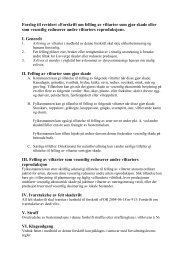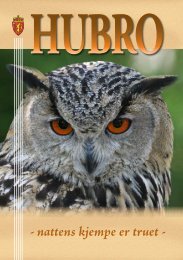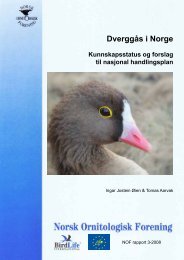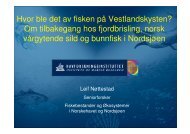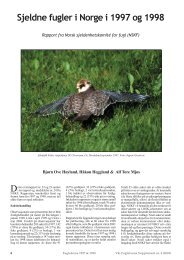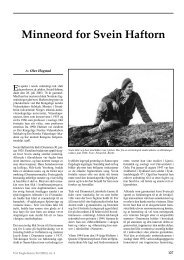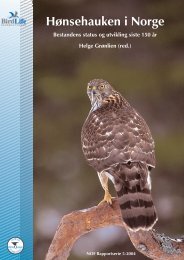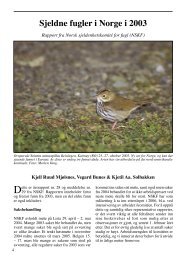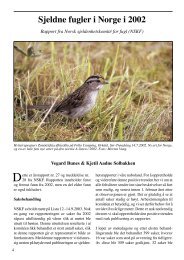Fennoscandian Lesser White-fronted Goose conservation project ...
Fennoscandian Lesser White-fronted Goose conservation project ...
Fennoscandian Lesser White-fronted Goose conservation project ...
Create successful ePaper yourself
Turn your PDF publications into a flip-book with our unique Google optimized e-Paper software.
<strong>Fennoscandian</strong> <strong>Lesser</strong> <strong>White</strong>-<strong>fronted</strong> <strong>Goose</strong> <strong>conservation</strong> <strong>project</strong> – Annual report 1999<br />
Aarvak & Øien: Monitoring of staging <strong>Lesser</strong> <strong>White</strong>-<strong>fronted</strong> Geese at the Valdak Marshes in 1999<br />
Monitoring of staging <strong>Lesser</strong> <strong>White</strong>-<strong>fronted</strong> Geese at the Valdak<br />
Marshes in 1999<br />
24<br />
Tomas Aarvak & Ingar Jostein Øien<br />
Norwegian Ornithological Society (NOF), Seminarplassen 5, N-7540 Klæbu, NORWAY, e-mails: tomas@birdlife.no, ingar@birdlife.no<br />
1. Introduction<br />
Several staging areas for <strong>Lesser</strong> <strong>White</strong>-<strong>fronted</strong> Geese (Anser erythropus,<br />
later LWfG) existed in Norway until the 1950's, but at present only two<br />
areas seems to be important for the small remaining population in the<br />
northernmost areas of Fennoscandia. The traditional staging area at<br />
Valdak is situated in the Porsangen Fjord in Western Finnmark, and the<br />
other, Skjåholmen, which was rediscovered as a staging area in 1994, is<br />
situated in the Varangerfjord in eastern Finnmark. Both places are utilised<br />
as the last staging area before the onset of breeding and as the first<br />
staging area after the moulting period. These two staging areas support<br />
geese from two separate breeding areas. The LWfG utilising Valdak<br />
breed in western and central Finnmark, while the LWfG staging on<br />
Skjåholmen and the surrounding coastal areas in the Varangerfjord breed<br />
in eastern Finnmark and northern Finland (Lorentsen et al. 1999, own<br />
unpublished data). However, it is very likely that the two groups meet<br />
during the migration and wintering period, since they utilise the same<br />
staging areas during autumn migration (Lorentsen et al. 1998).<br />
The <strong>Fennoscandian</strong> LWfG <strong>project</strong> run by WWF Finland and NOF<br />
has monitored the two staging areas annually since 1995 (Skjåholmen)<br />
and 1990 (Valdak) respectively. The results of the monitoring work from<br />
October 1998 to November 1999 at the Valdak Marshes is reported in<br />
this article, which reiterates all results presented in earlier yearly reports<br />
(see Aarvak et al. 1996, 1997, Aarvak & Øien 1999) from the monitoring<br />
and research work, but more comprehensive discussions are omitted.<br />
This summary is restricted to short comments on the results from 1999.<br />
For results of the monitoring work at Skjåholmen, see Tolvanen (2000,<br />
pp. 28–31 in this report).<br />
2. Study area and methods<br />
The Valdak Marshes (N 70°09’, E 24°54’) is a part of the Stabbursnes<br />
Nature Reserve, which is a Ramsar site and a BirdLife International<br />
Important Bird Area (Norwegian IBA 010; cf. Lislevand et al. 2000).<br />
It is one of the largest salt and brackish marshes in northern Norway<br />
(Elven & Johansen 1982), and represent an extremely important<br />
feeding area for the LWfG in Fennoscandia. The salt tolerant grass<br />
Puccinellia phryganodes is the staple food for the geese during spring<br />
staging. In autumn, they have a much wider diet, comprising Festuca<br />
rubra, Puccinella phryganodes, Eleocharis uniglumis, Agrostris<br />
stolonifera, Juncus gerardi and Elymus arenarius (Aarvak et al. 1996).<br />
Valdak is demarcated inwards from the fjord by Stabbursnes,<br />
which is a headland made up of glacifluvial depositions. It constitutes<br />
of a natural watching point with a height of c. 25 metres above the<br />
wet mires and the salt-marshes of Valdak. During the studies, the<br />
observers sit close to the edge of the headland, just beneath the rim,<br />
to ensure that their silhouettes can not be seen from beneath. Under<br />
such circumstances, the foraging birds can easily be studied at a<br />
distance of 250–500 metres without any disturbance to the birds using<br />
a telescope (20–60 x magnification).<br />
From 1998 on we have used a new method, by utilising a videocamera<br />
(Sony Handycam) to film the geese through the telescope.<br />
This method increased significantly the possibilities for accurate<br />
individual identification and age determination of the staging geese<br />
(Aarvak et al. 1999). By this method it is possible to distinguish<br />
subadult pairs from adult pairs, and to more securely separate single<br />
subadults from immatures and subadult pairs from adult ones.<br />
Subadults are here defined as birds in their third calendar year, while<br />
immatures are in their second calendar year (see Øien et al. 1999<br />
about details on ageing).<br />
The aim of the spring monitoring (13 May - 6 June) was to follow<br />
the progress of migration and the total number of staging LWfG in<br />
the area. As in former years, the individuals were identified by the<br />
individual uniqueness of the belly patches. A thorough description<br />
of the method is given by Øien et al. (1996). The number of staging<br />
individuals and staging time for the pairs (turnover rates) were<br />
monitored. In addition, daily activity of individuals and flocks, food<br />
preferences, tolerance of disturbance, habitat use, flying activity and<br />
migratory movements have been registered.<br />
During autumn (20 August – 5 September) emphasis was put on<br />
carrying out counts of families and social groups in order to obtain<br />
estimates on brood size, productivity and proportion of immatures<br />
in the population. Also during the autumn staging the flocks and<br />
individual pairs with goslings were recorded by video-camera.<br />
Since 1995 number of LWfG has been caught, both in Norway,<br />
Finland and Russia to map the migration routes by use of satellite<br />
telemetry. A few individuals have also been colour-ringed. This has<br />
provided further knowledge together with the results obtained by<br />
the satellite telemetry (see Aarvak et al. 1999). In autumn 1999 we<br />
wanted to catch more geese for colour-ringing. One net covering an<br />
area of 1600m 2 was mounted in the staging period for the geese, but<br />
no catching possibilities occurred. The catching attempt was carried<br />
out together with the Finnish LWfG Life <strong>project</strong>.<br />
3. Results<br />
3.1. Spring staging<br />
The first three LWfG arrived during midday and afternoon on 14<br />
May. Thereafter the numbers increased fast on 19 and 20 May,<br />
Table 1. Overview of numbers of <strong>Lesser</strong> <strong>White</strong>-<strong>fronted</strong> Geese at the Valdak Marshes in the springs 1993–99. The table shows the maximum<br />
number of staging geese at the best day, distribution of adult pairs, subadult pairs, single subadults, single adults and immatures, as well as<br />
total number of staging individuals each spring.<br />
Year Max no. no. of no. no. of no. of Proportion of Total<br />
on one of. ad subad of single single imm./single no. of<br />
day pairs pairs imm subadults adults subads ind.<br />
1993 32 32 – 4 – – 5.9 % 68<br />
1994 24 26 – 4 – – 7.1 % 56<br />
1995 48 >25 – >10 – – >16.7 % >60<br />
1996 31 23 – 10 – – 17.9 % 56<br />
1997 32 26 – 7 – – 11.9 % 59<br />
1998 37 33 5 5 3 – 21.4 % 84<br />
1999 35 22 3 71 – 1 25.9 % 2 58<br />
1 Not included two immatures in pair with adults which is included in the “no. of ad. pairs” column.<br />
2 Also included two immatures in pair with adults which is included in the “no. of ad. pairs” column.



